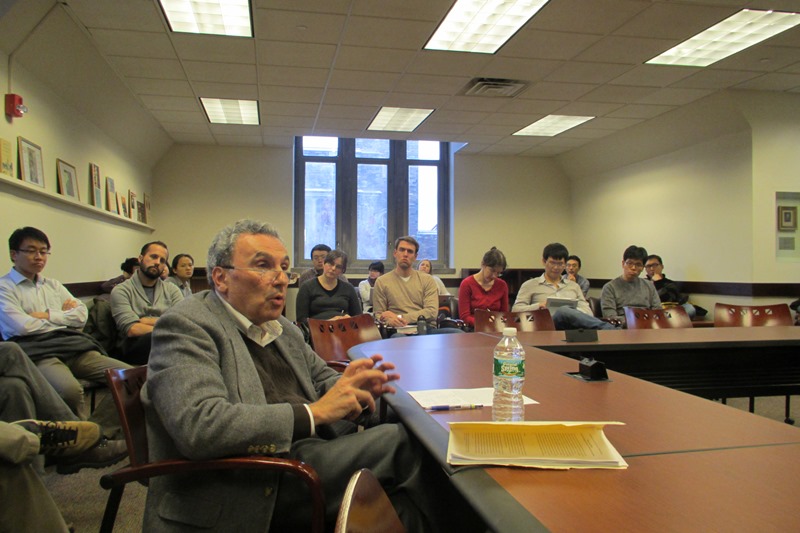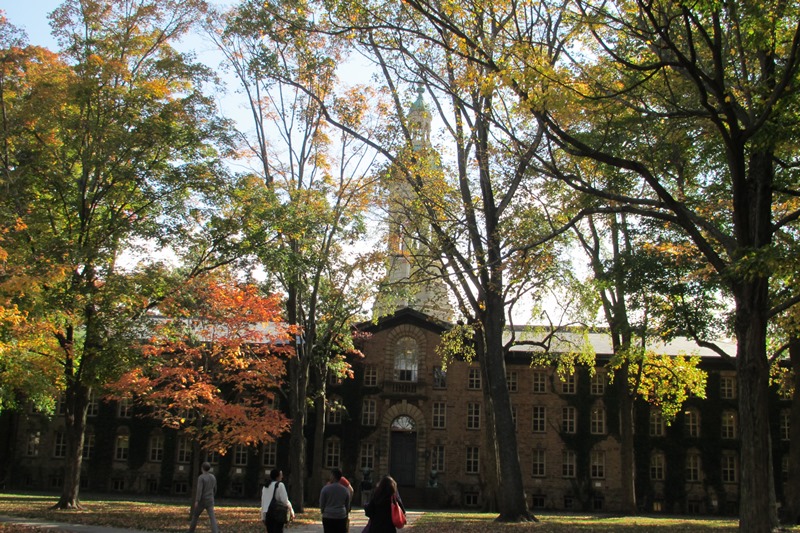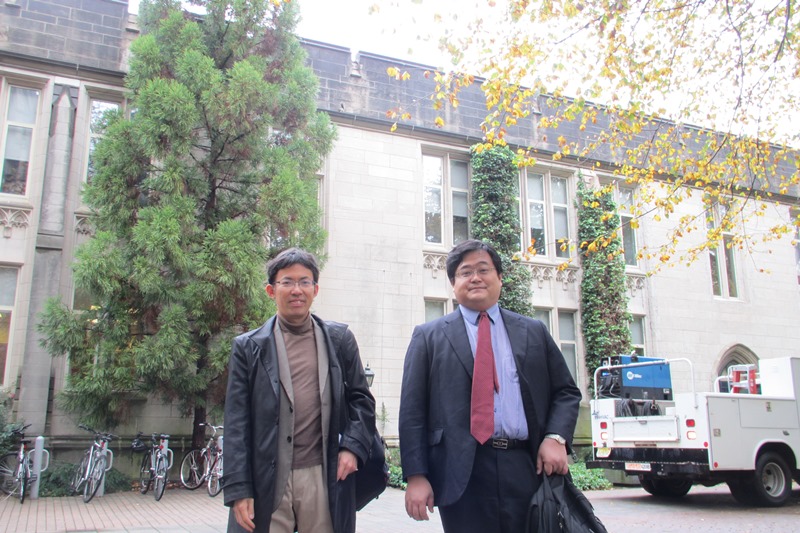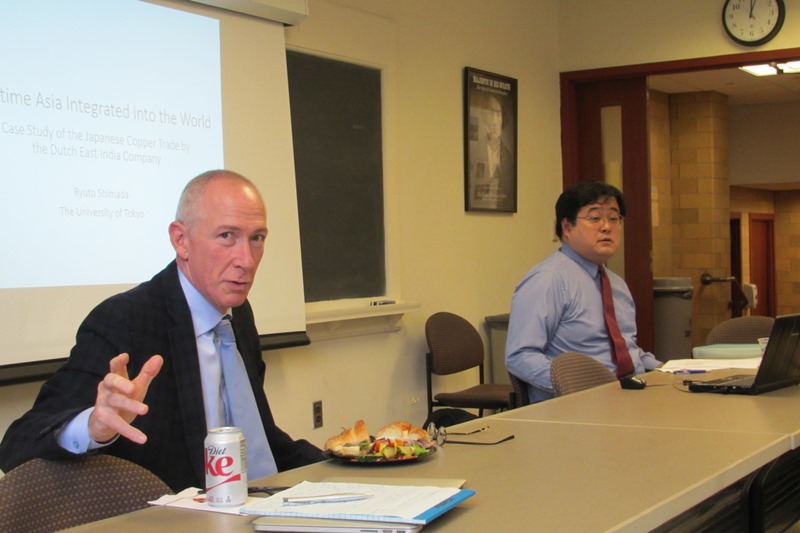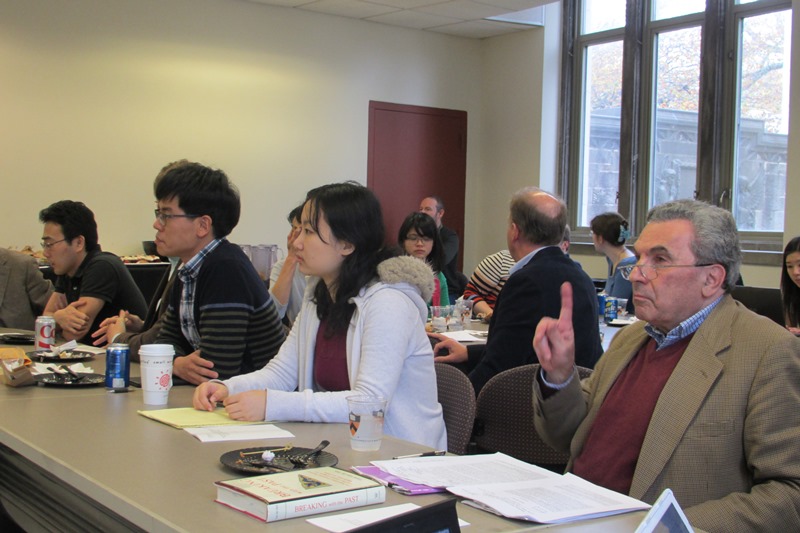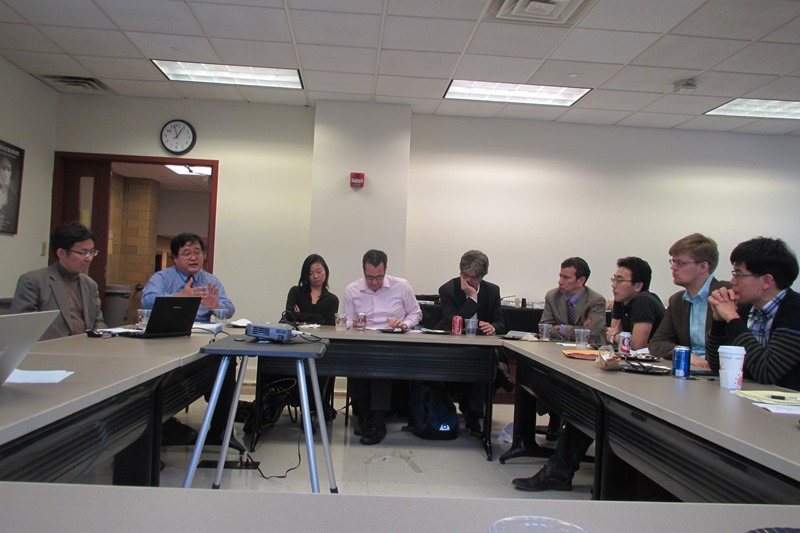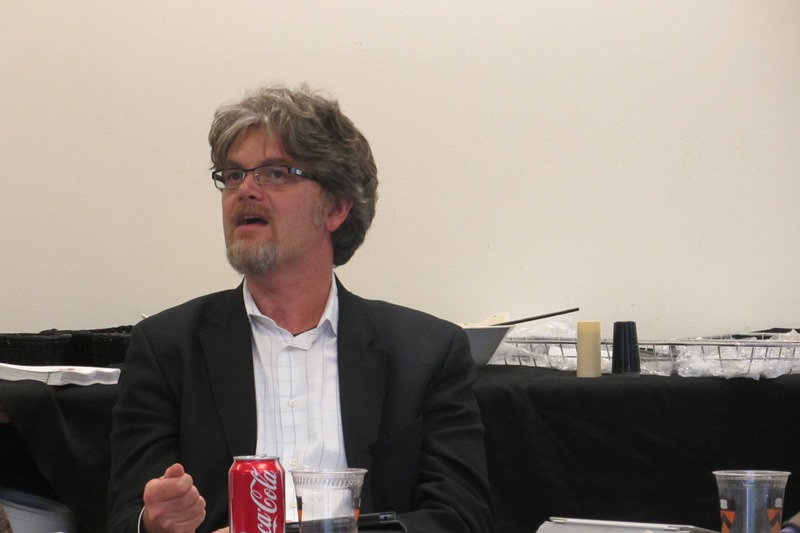2014.10.27
プリンストン大学におけるグローバルヒストリー・ワークショップ Workshop at Princeton University
10月22日(水)、プリンストン大学のDickinson Hallで、Global History Collaborativeのワークショップが開催された。
昼食をとりながら参加者が自由に語り合うという形の気楽な雰囲気の会だった。Jeremy Adelman教授が司会を担当し、まず、島田竜登、村上衛両氏があらかじめ配布していたペーパーの内容を要約して説明した。
島田氏は、”Maritime Asia Integrated into the World: A Case Studies of the Japanese Copper Trade by the Dutch East India Company”と題して報告した。17-18世紀におけるオランダ東インド会社による日本産銅の貿易の実体が紹介され、銅の行き先の時代による変遷、華人商人のジャンク貿易との競争、徳川政権や清朝の政策がオランダ東インド会社の貿易に与えた影響などが論じられた。
村上氏の報告は”The Small Divergence within East Asia: Crisis in the 19th Century in China and Japan”と題され、同じ東アジアに位置する中国と日本が、19世紀後半以後異なった進路をたどった理由が、政治、制度、社会など様々な角度から論じられた。「ヨーロッパ」と「非ヨーロッパ」の間の比較だけではなく、「非ヨーロッパ」とされた地域の間での比較も必要だとの考えに基づいた議論である。
両報告の後で一時間近く活発な質疑応答と議論が続いた。いずれも高度でかなり専門的な内容だったが、全般に、両氏の報告を日本や東アジアの過去をグローバルヒストリーの文脈に位置づけようとする挑戦的な試みとして高く評価するコメントが多かった。30名以上が出席し盛会だった。
翌10月23日(木)の午後、同じDickinson Hallで、East Asia and Global Historyと題するシンポジウムが開催された。東南アジア史研究者のMichael Laffan教授が司会を務め、Federico Marcon, Benjamin Elman, Sheldon Garonの三氏が、それぞれ東アジアとグローバルヒストリーに関連するテーマについて話題提供を行い、羽田がこれらに対してコメントした。三氏の議論は多岐に亘ったが、共通していたのは、世界史/グローバルヒストリーにおける東アジア史の位置と意味、グローバルヒストリーの方法、日本史の無視や日本史が特殊であるという「思い込み」への対応などの点だった。羽田は英語と日本語における「世界史」「グローバルヒストリー」の意味のズレ、「中国」、「日本」など歴史を語る際の主語、「東アジア」という枠組みの3点についてコメントを述べた。二十数人が集まった会場からも様々な意見が出され、30分あまりではあったが、充実した議論が展開された。
二つの会合の終了後、島田、村上両氏と羽田の間でまとめの意見交換を簡単に行った。その概要は、以下の3点である。
1.両日とも学生を含めて参加者が多く、企画としては成功だった。このような試みを積み重ねてゆくことにより、日本の研究者の研究成果や視点、方法を相当程度海外の研究者に紹介することができ、有意義な国際共同研究を展開することができるだろう。
2.両日とも、Adelman教授をのぞく主な発言者は東アジア研究科の教員で、アメリカでも必ずしも地域を超えて「グローバルヒストリー」の議論が盛んに行われているわけではないようだ。
3.アメリカ(英語)のglobal historyと日本(日本語)のグローバルヒストリーの間には、問題関心や研究の方法において無視できない「ズレ」がある。このことを意識しながら、交流を進めることが必要だろう。
(文責:羽田正)
A workshop of the Global History Collaborative was held on Wednesday, October 22, 2014, at the Dickinson Hall in Princeton University. The workshop was held in a friendly atmosphere with participants freely expressing their views over lunch. Under the moderation of Professor Jeremy Adelman, the meeting began with presentations by Shimada Ryuto and Murakami Ei, each of whom briefly explained the contents of their respective papers, which had been distributed to the participants beforehand.
Shimada presented the gist of his paper titled “Maritime Asia Integrated into the World: A Case Study on the Japanese Copper Trade by the Dutch East India Company.” After briefly explaining how copper that was produced in Japan was traded by the Dutch East India Company during the 17th and 18th centuries, he proceeded to touch on several topics, including the changes over time in the destinations of the copper from Japan, the competition which the Dutch East India Company faced from the trading activities of the junks that were operated by Chinese merchants, and the impact which the Tokugawa Shogunate and Qing Dynasty’s policies restricting maritime trade had on the Dutch East India Company’s trading activities.
In his presentation “The Small Divergence within East Asia: Crisis in the 19th Century in China and Japan,” Murakami explained why, when looked at from political, institutional, social, and other perspectives, China and Japan followed different paths from the latter half of the 19th century. Underlying his discussion was his conviction that it is necessary not only to compare “Europe” and “non-Europe,” but also to compare different regions belonging to what has usually been regarded as “non-Europe.”
The two presentations were followed by a nearly one-hour session of questions and answers and discussion. Both presentations were advanced and very sophisticated, and most of the comments were favorable, highly appraising the presenters’ challenging attempts to locate the past of Japan and East Asia in the context of global history. The meeting, which was attended by more than 30 participants, was a great success.
In the afternoon of the following day, Thursday, October 23, a symposium on “East Asia and Global History” was held in the same Dickinson Hall with Professor Michael Laffan, a researcher, who specializes in Southeast Asian history, serving as moderator, with more than twenty people attending. Three presenters, Messrs Federico Marcon, Benjamin Elman, and Sheldon Garon, took turns to furnish topics for discussion on themes related to East Asia and global history, and Haneda made comments on their presentations. The arguments made by the three presenters covered a broad array of themes, but they all pointed out the importance of the need to clarify the locus and significance of East Asian history in world history or global history, to establish the methodology of global history, and to deal with the neglect of Japanese history and the “presumption” that Japan’s history was singular. In his comments, Haneda drew attention to three specific points: the existence of subtle differences in meaning between the English and Japanese expressions for “world history” and “global history, ”the problems involved in the use of “China,” “Japan,” or any other geographical entity as a subject of historical discourse, and the problems involved in the use of the term “East Asia.” Various opinions were expressed from the floor, and a lively and fulfilling discussion took place, even though it could only last a little over 30 minutes.
After the two meetings, the three participants from Japan briefly reviewed the two days’ events, and shared their impressions. Their main conclusions can be summarized under the following three points:
- The two-day event, which drew many participants, including students, turned out to be a success. It would be meaningful to continue to hold similar events in the future, because they are expected to be effective in disseminating abroad the research findings and views of Japanese researchers, and can facilitate meaningful international collaborative research.
- The main participants in the two-day event who spoke up frequently were all faculty members of the Department of East Asian Studies, with the exception of Professor Adelman. This seems to suggest that in the United States, as in Japan, “global history” is not yet a focus of active discussion among historians who are regional specialists.
- There is a far from negligible gap between the American (or English) term “global history” and the Japanese term “gurobaru hisutorî” with regard to the two questions of consciousness and research methodology. It is necessary, while promoting the exchange program, to remain deeply conscious of this discrepancy.









